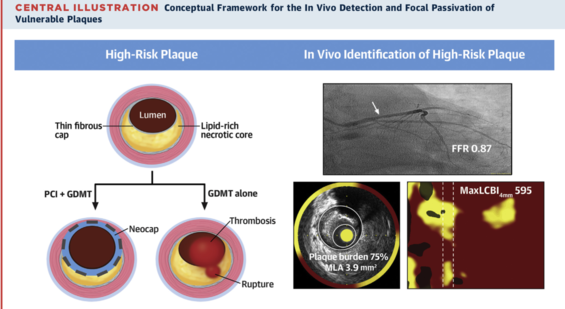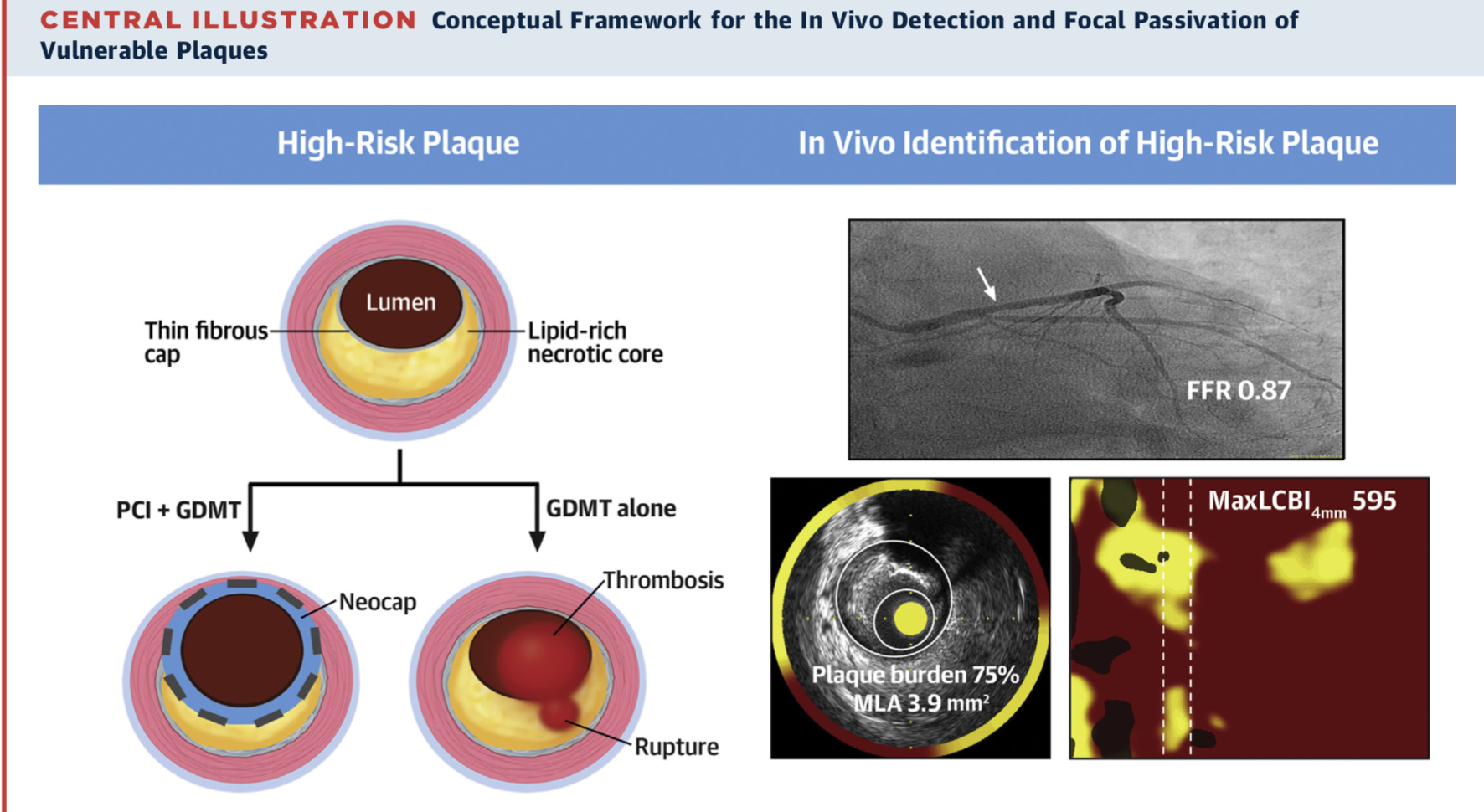Percutaneous coronary intervention for vulnerable coronary atherosclerotic plaque
Selected in JACC by S. Brugaletta
Do you have any experience with NIRS technology? Do you think that use of 3rd generation DES would have shown better results than BVS? Read this review by S. Brugaletta
References
Authors
Gregg W. Stone, Akiko Maehara, Ziad A. Ali, Claes Held, Mitsuaki Matsumura, Lars Kjøller-Hansen, Hans Erik Bøtker, Michael Maeng, Thomas Engstrøm, Rune Wiseth, Jonas Persson, Thor Trovik, Ulf Jensen, Stefan K. James, Gary S. Mintz, Ovidiu Dressler, Aaron Crowley, Ori Ben-Yehuda, David Erlinge, and PROSPECT ABSORB Investigators
Reference
J Am Coll Cardiol. 2020 Nov, 76 (20) 2289–2301
Published
November 2020
Link
Read the abstractReviewer
Latest contributions
PARTNER 3: transcatheter or surgical aortic-valve replacement in low-risk patients at 7 years 1-year SELUTION DeNovo results: what they mean for daily practice Optical coherence tomography- vs angiography-guided coronary stent implantation in calcified lesions: the ILUMIEN IV trialMy Comment
Why this study? – the rationale/objective
Acute coronary syndromes most commonly arise from thrombosis of lipid-rich coronary atheromas that have large plaque burden despite angiographically appearing mild. This study sought to examine the outcomes of percutaneous coronary intervention (PCI) of non–flow- limiting vulnerable plaques.
How was it executed? – the methodology
Three-vessel imaging was performed with a combination of intravascular ultrasound (IVUS) and near-infrared spectroscopy (NIRS) catheter after successful PCI of all flow-limiting coronary lesions in patients presenting with myocardial infarction (MI).
Patients with angiographically nonobstructive stenosis not intended for PCI but with IVUS plaque burden of >65% were randomized to treatment of the lesion with a bioresorbable vascular scaffold (BVS) plus guideline-directed medical therapy (GDMT) versus GDMT alone. The primary powered effectiveness endpoint was the IVUS-derived minimum lumen area (MLA) at protocol-driven 25-month follow-up. The primary (nonpowered) safety endpoint was randomized target lesion failure (cardiac death, target vessel–related MI, or clinically driven target lesion revascularization) at 24 months. The secondary (nonpowered) clinical effectiveness endpoint was randomized lesion– related major adverse cardiac events (cardiac death, MI, unstable angina, or progressive angina) at latest follow-up.
What is the main result?
A total of 182 patients were randomized (93 BVS, 89 GDMT alone) at 15 centres.
Angiographic follow-up at 25 months was completed in 167 patients (91.8%), and the median clinical follow-up was 4.1 years. The follow-up MLA in BVS-treated lesions was 6.9 ±2.6 mm2 compared with 3.0 ± 1.0 mm2 in GDMT alone–treated lesions (least square means difference: 3.9 mm2; 95% confidence interval: 3.3 to 4.5; p < 0.0001).
Target lesion failure at 24 months occurred in similar rates of BVS-treated and GDMT alone–treated patients (4.3% vs. 4.5%; p = 0.96). Randomized lesion–related major adverse cardiac events occurred in 4.3% of BVS-treated patients versus 10.7% of GDMT alone–treated patients (odds ratio: 0.38; 95% confidence interval: 0.11 to 1.28; p = 0.12).

Illustration credit: JACC
Critical reading and the relevance for clinical practice
This is a very elegant study about preventive treatment of a vulnerable plaque before an acute event may occur. The study was prematurely terminated due to the withdraw of the ABSORB from the market. First of all, it is interesting to see once more the value of the NIRS technology in detecting lipid plaque which may be cause of future events. The fact that this technology is not available in many centres does not allow unfortunately to have many studies on it.
Second, it is quite clear that if we implant a stent, we end up with a smaller MLA as compared to GDMT; however, it is good to see that this does not translate into an increase in clinical event. Conversely, the study interestingly showed lower MACE rate in patients treated with BVS as compared to those treated by GDMT alone (not significant); of note that events such as progressive angina were considered within MACE, although some may not consider them as an effect of a vulnerable plaque.
In conclusion, this study should be considered as a proof of concept for the preventive vulnerable plaque treatment, to be used in the design of a larger trial, powered on events reduction rather than MLA. Do you have any experience with NIRS technology? Do you think that use of 3rd generation DES would have shown even better results than BVS?





No comments yet!